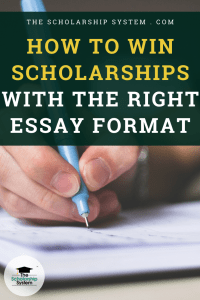Updated on October 25th, 2021
We all know that scholarships are great. Being selected for an award means your child can pay less out of pocket for college while avoiding costly student loans and other debts. Typically, your student needs to write an essay for scholarship applications, and having the right scholarship essay format is critical.
Often, students get distracted by the content requirements of the essay, so your child may neglect scholarship essay format details that can set them apart from the crowd (and help judges understand what they are trying to say!)
To help your student reach the higher echelons of success, here are some scholarship essay format tips that can increase their odds of getting noticed for the right reasons. And if you are curious where to find scholarships that your child is actually eligible, you can learn more here.
Follow All Scholarship Essay Format Directions
First and foremost, your child needs to follow any instructions that are listed regarding the scholarship essay format. This includes aspects like word count, line spacing, font choice, and the use of headings.
If an organization provides guidelines about the scholarship essay format, these are there to ensure everyone is competing at the same level AND to make sure your student can effectively follow directions.
Failing to follow the rules about scholarship essay format can lead your child to be immediately disqualified, so these should always take precedence over personal preferences or standard guidelines regarding how letters are constructed.
In many cases, requirements like word count, spacing, and font ensure that the scholarship committee can successfully review the anticipated number of submissions within the time they have available. And, typically, they won’t make exceptions.
For example, if an essay needs to be 300 words, the committee will likely be fine with submissions that aren’t exactly 300, as hitting a target that specific can be challenging. So, if your child submits a piece that is 297 or 304 words, that could be okay. However, if your student turns in a 400-word essay, they’ll likely disqualify themselves from consideration. In the end, the closer to the target, the better. In our online course for students, we recommend always maximizing the word count by getting as close to the limit as possible but avoiding going over.
Standard Scholarship Essay Format

Generally, this means creating a piece consisting of three or more paragraphs, with each paragraph being at least three sentences long. The introductory paragraph should contain a thesis statement that provides an overview of what will be discussed while the last paragraph should be dedicated to a conclusion and reiterating the primary point.
Any middle sections provide additional depth to the essay and typically represent the bulk of the content. However, in a standard scholarship essay format, each paragraph should focus on a single point that supports the larger thesis. When it’s time to cover a different point, another paragraph should be created, preferably leading off with transition sentence that creates a bridge between the previous point and the next.
Scholarship Essay Format Tips
When there isn’t specific guidance, your child may struggle with certain formatting choices.
To help them navigate tricky scholarship essay format decisions, here are some general tips:
- When not otherwise specified, your student should use a font size between 10 and 12 points.
- Arial, Calibri, Tahoma, Times New Roman, and Verdana fonts are typically considered the easiest to read and more professional, so your child one of those if a specific one isn’t required.
- If there is a page requirement (such as when a scholarship committee requests a two-page essay), your student shouldn’t use double spacing to meet the minimum unless it is explicitly requested. Otherwise, it may be perceived that your child is trying to take a shortcut. However, if there is no page minimum, 1.5 or double line spacing is acceptable.
- Your student can designate new paragraphs by either adding an extra blank line or by indenting the first line. However, they shouldn’t do both.
- Make sure to set all paper margins to one inch.
- If the essay must be printed and mailed, use a high-quality paper and use an envelope that prevents your student from having to fold the document.
- This sounds crazy but some committees specifically state not to staple the materials. If that’s the case, make sure not to staple them! Silly little things like this can lead to disqualifications (we’ve seen it..)
- Your child should always double (if not triple) check their scholarship essay for spelling or grammatical errors as these can significantly hurt their chances of being selected.
Keeping the Content on Target
As your child writes their scholarship essays, it’s easy for them to drift off on a tangent. While they may find the additional details interesting, falling off target can be seen as them not following instructions, a lack of focus, or trouble with self-editing.
When writing their scholarship essay, your student needs to ask themselves a few key questions, including:
- Can the scholarship committee follow what I am saying or the story I’m telling?
- If I didn’t know what the essay prompt was, could I reasonable ascertain it based on the content of this piece?
- Does the story focus on me (even when asked about role models) or do I spend too much time focusing on someone else?
That third point can be especially tricky when an essay question is asking about role models or people who’ve influenced your child’s life. While your student needs to touch on what they found inspiring about the person, they should spend the majority of the content talking about how they were moved/inspired/influenced and what that means for their lives. The rest can provide the necessary backstory and other details about their role model.
Ultimately, the scholarship essay format and content need to provide a cohesive narrative that helps the judges learn about your child.
If any part of the content doesn’t stay on target, it needs to be adjusted or removed. This is especially true when there is a word count or page length requirement, as superfluous details may look like your student was trying to create filler content or “fluff” as a means of hitting the minimum.
Reviewing the Essay
Ideally, your child should enlist the help of someone else, such as a trusted teacher, friend, or parent (like you!) to review their essays before they are submitted. Often, it is easier for a fresh set of eyes to catch errors that may be overlooked by the person who wrote the piece. Additionally, it can serve as confirmation that your student stayed on target and that everything feels cohesive when it’s reviewed by someone who hasn’t created it (or even knows what the prompt was).
Now, that doesn’t mean you should assume your child will want you to do the revisions. It can be tough to have writings as personal as scholarship essays read by family members, as it may make them feel vulnerable or uncomfortable. And, in the end, being able to write openly and honestly about their experiences can be the difference that sets them apart and helps them score scholarships.
So, don’t be afraid to offer your help, but, if your child says no, remember that that’s okay. Just be there to support them through this journey and provide encouragement. In the end, that can make more of a difference in the long-term than taking a red pen to their essay ever could.
What is the craziest essay prompt you’ve seen? Share it below!
Did you find this helpful? If so, share it with your friends and family so they don’t forget anything either.
Related Articles:
- Make Scholarship Essays Stand Out by Avoiding These 4 Clichés
- 3 Quick Tricks to Streamlining Your Scholarship Process
Related Videos:



Thanks for info!
My pleasure!
Set aside time each day to search for and apply to scholarships. You should be consistent in your search and make sure you are continually giving yourself every opportunity to win a scholarship. Don’t give up! It will take time and effort, but with the right focus, you can find the scholarship that is right for you.
Great advice!
Loving your tips on reading the essay and pinpointing vague areas, as well as your suggestion that the essay as a whole should leave no doubt as to what the essay is about!